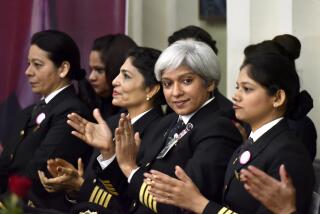Commentary : Aviation’s Oft Maligned ‘Small Planes’ Often Fly Off to Do Big Jobs
- Share via
Inevitably, after the crash of a “small plane”--and regrettably there has been a flurry of five such mishaps in the past week in Southern California--we hear an outburst of public demands for airport closures, highly restrictive measures on “general aviation” or the more common “just get those small planes out of there,” meaning, I presume, the skyways in general and, in this area, John Wayne Airport in particular.
Crashes are always very serious matters to those of us in aviation and as the individual responsible for flight operations at Martin Aviation Inc., I am always concerned about safety. But my concern is not limited to the airways; as one who also drives regularly, I am also concerned about safety on the highways.
Five accidents on the freeways, even five fatal accidents, have never produced a public demand to close down the freeways. And as one who listens to the morning and late afternoon rush-hour traffic reports, I am well aware that there are at least five accidents every hour. But somehow, we have become inured to those, even the fatal ones.
Instead, the media and the public tend to focus their attention on accidents involving “small planes.” With all this attention, even though it might be understandable, I also perceive a public misunderstanding that deeply concerns me.
It has been correctly stated in several recent media stories that general aviation amounts to 84%, or more, of the takeoffs and landings at John Wayne Airport. Unfortunately, the public’s impression seems to be that general aviation is made up almost entirely of “small planes” and the people who fly them for “fun and sport.” That just isn’t the case.
General aviation includes everything from the small two-seat Cessna 152s to the large 12- to 19-passenger executive jets. It can even be the larger 727s or DC-9s, which many corporations own. And it includes any number of helicopters that can carry up to six or eight people.
Here are some other statistics about general aviation that the public seldom hears:
* For every hour flown by commercial airlines, general aviation (all flights except military and scheduled airlines) will fly at least three. The so-called “pleasure aircraft” departing from Martin Aviation and the many other general aviation facilities here and across the nation are a relatively small percentage of our flight operations.
* Business aircraft, either privately or corporately owned or chartered, account for an ever-increasing percentage of our operations and enable the business leaders of our community to travel safely and conveniently to thousands of places not served by the airlines. There are about 12,000 airports in areas not reached by the major carriers. General aviation is their only air link to the rest of the world.
* General aviation plays a vital role in health-related services, transporting blood supplies, vital organs for transplants and carrying seriously ill or critically injured persons to hospitals and trauma facilities, often for specialized forms of treatment. General aviation also provides vital search and rescue missions that we read about or see on TV regularly.
* General aviation provides a new dimension for law enforcement by providing planes used to prevent crimes, provide officer backups, apprehend suspects, patrol the nation’s borders, protect government officials and VIPs and enforce speed limits.
* General aviation serves the traffic reporters who assist millions of commuters by reporting traffic tie-ups.
* General aviation serves agriculture by helping farmers treat and service more than 140 million acres of land. Sixty-five percent of all commercially applied crop protection services are done from the air, enabling the agricultural industry to supply food for our tables and fiber for our clothes.
* Specially equipped general aircraft are used to conduct wildlife surveys, map wetlands losses, follow bird migrations, patrol parklands and inspect vital oil, gas and water lines.
General aviation aircraft provide many other services as well. They carry canceled checks to the Federal Reserve Banks throughout the nation, they fly overnight packages and communications and take mail to out-of-the-way locations, allow advance warning of severe weather, check for soil erosion and help locate and fight brush and forest fires.
In addition, general aviation volunteer pilots take doctors, nurses and medical supplies to remote places. The Orange County chapter of LIGA International (the Flying Doctors of Mercy) departs regularly from Martin Aviation for remote areas of Mexico.
With all this, how can they be called “small planes” when they do such big things? On the economic side, general aviation provides more than 250,000 jobs nationwide with an annual payroll of more than $2.7 billion.
John Wayne Airport has logged anywhere from 400,000 to 600,000 flight operations every year since the airport was expanded in 1965. Historically, 84% of those are credited to general aviation. Yet the number of safety incidents, including so-called “near misses” between airliners and general aviation flights, is minuscule by comparison. In fact, airline passengers are much more likely to have a serious “near-miss” on the freeways going to or from the airport than they are departing or arriving on an airliner thanks to the training and the skill of those at the controls of both types of aircraft and those in the control tower.
The next time you hear one of those “small planes” overhead, stop and think about the purpose of that flight. It could be one that adds a service to your life.
More to Read
Inside the business of entertainment
The Wide Shot brings you news, analysis and insights on everything from streaming wars to production — and what it all means for the future.
You may occasionally receive promotional content from the Los Angeles Times.










